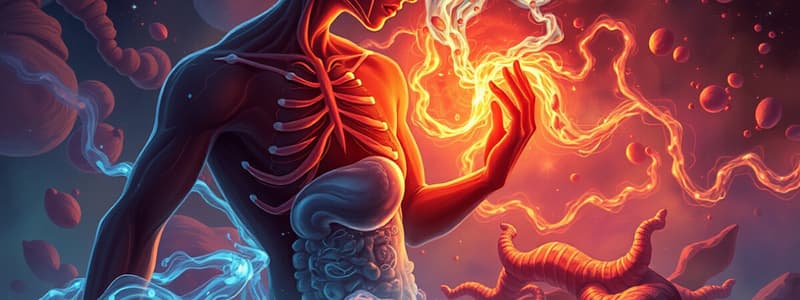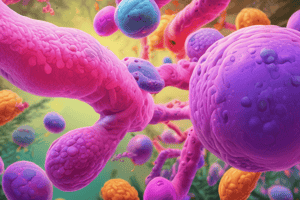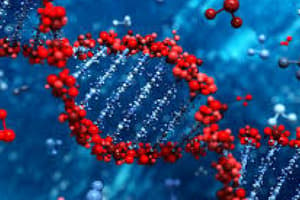Podcast
Questions and Answers
What is one of the primary functions of the small intestine?
What is one of the primary functions of the small intestine?
- To store bile for fat digestion
- To excrete waste from the body
- To break down food and absorb nutrients (correct)
- To produce hormones for digestion
What are the three main parts of the small intestine?
What are the three main parts of the small intestine?
- Pylorus, Jejunum, Sigmoid
- Cecum, Colon, Rectum
- Esophagus, Stomach, Duodenum
- Duodenum, Jejunum, Ileum (correct)
Which part of the small intestine is characterized by a rich blood supply and receives food from the stomach?
Which part of the small intestine is characterized by a rich blood supply and receives food from the stomach?
- Cecum
- Ileum
- Duodenum (correct)
- Colon
What is extracted from the digested mixture in the small intestine?
What is extracted from the digested mixture in the small intestine?
How does the structure of the ileum differ from the other parts of the small intestine?
How does the structure of the ileum differ from the other parts of the small intestine?
Which nutrient types are primarily absorbed by the small intestine?
Which nutrient types are primarily absorbed by the small intestine?
What distinguishes the jejunum from other sections of the small intestine?
What distinguishes the jejunum from other sections of the small intestine?
How does the ileum contribute to nutrient absorption?
How does the ileum contribute to nutrient absorption?
What is the primary role of the small intestine in the digestive system?
What is the primary role of the small intestine in the digestive system?
Which section of the small intestine is the initial point where food enters after leaving the stomach?
Which section of the small intestine is the initial point where food enters after leaving the stomach?
Flashcards are hidden until you start studying
Study Notes
Pancreatic Function and Digestion
- Failure to secrete pancreatic juice leads to abnormal digestion, often due to pancreatitis, gallstone blockage, or post-surgery.
- Essential enzymes like trypsin, chymotrypsin, and pancreatic lipase are crucial for fat digestion; their absence causes impaired fat absorption and fatty feces.
- Chloride ions are primarily absorbed in the upper small intestine via diffusion, assisted by sodium ions that create an electrical gradient.
Role of Pancreatic Amylase
- Pancreatic secretion includes a potent α-amylase enzyme, significantly stronger than salivary amylase.
- Most carbohydrates are digested within 15 to 30 minutes of chyme entering the duodenum and mixing with pancreatic juice.
Collaboration with Other Organs
- The digestive process in the small intestine is supported by neighboring organs:
- Liver: Produces bile to emulsify fats for improved digestion.
- Gallbladder: Stores bile until it’s released into the small intestine.
- Pancreas: Secretes digestive enzymes through the pancreatic duct.
Digestion in the Small Intestine
- Enzymes are responsible for breaking down food into smaller molecules:
- Proteins: Broken down into amino acids.
- Lipids (Fats): Broken down into fatty acids and glycerol by lipases.
- Carbohydrates: Amylases convert complex carbohydrates into simpler sugars.
- Peristalsis moves food rhythmically through the small intestine, similar to a conveyor belt.
Nutrient Absorption and Water Extraction
- Villi, tiny finger-like projections lining the small intestine, increase surface area for nutrient absorption.
- Nutrients such as amino acids, sugars, and fatty acids pass through the intestinal walls into the bloodstream.
- The small intestine extracts water from digested material, contributing to hydration.
Anatomy of the Small Intestine
- The small intestine is the longest portion of the gastrointestinal tract, consisting of three main parts:
- Duodenum: Short, curved section connecting to the stomach; first part of the small intestine.
- Jejunum: Middle section, rich in blood supply, giving it a deep red color.
- Ileum: The longest segment, where walls thin and nutrient absorption occurs.
Pancreatic Function and Digestion
- Failure to secrete pancreatic juice leads to abnormal digestion, often due to pancreatitis, gallstone blockage, or post-surgery.
- Essential enzymes like trypsin, chymotrypsin, and pancreatic lipase are crucial for fat digestion; their absence causes impaired fat absorption and fatty feces.
- Chloride ions are primarily absorbed in the upper small intestine via diffusion, assisted by sodium ions that create an electrical gradient.
Role of Pancreatic Amylase
- Pancreatic secretion includes a potent α-amylase enzyme, significantly stronger than salivary amylase.
- Most carbohydrates are digested within 15 to 30 minutes of chyme entering the duodenum and mixing with pancreatic juice.
Collaboration with Other Organs
- The digestive process in the small intestine is supported by neighboring organs:
- Liver: Produces bile to emulsify fats for improved digestion.
- Gallbladder: Stores bile until it’s released into the small intestine.
- Pancreas: Secretes digestive enzymes through the pancreatic duct.
Digestion in the Small Intestine
- Enzymes are responsible for breaking down food into smaller molecules:
- Proteins: Broken down into amino acids.
- Lipids (Fats): Broken down into fatty acids and glycerol by lipases.
- Carbohydrates: Amylases convert complex carbohydrates into simpler sugars.
- Peristalsis moves food rhythmically through the small intestine, similar to a conveyor belt.
Nutrient Absorption and Water Extraction
- Villi, tiny finger-like projections lining the small intestine, increase surface area for nutrient absorption.
- Nutrients such as amino acids, sugars, and fatty acids pass through the intestinal walls into the bloodstream.
- The small intestine extracts water from digested material, contributing to hydration.
Anatomy of the Small Intestine
- The small intestine is the longest portion of the gastrointestinal tract, consisting of three main parts:
- Duodenum: Short, curved section connecting to the stomach; first part of the small intestine.
- Jejunum: Middle section, rich in blood supply, giving it a deep red color.
- Ileum: The longest segment, where walls thin and nutrient absorption occurs.
Studying That Suits You
Use AI to generate personalized quizzes and flashcards to suit your learning preferences.




